
Do you want to get traffic from Google?
This guide will introduce you to SEO, how search engines work, and the techniques to make your site rank on top.
What Is SEO
SEO stands for Search Engine Op. It’s the process of improving your website’s visibility on search engines like Google. The goal is to rank higher for keywords that your potential customers are searching for, and thereby increase the amount of free, otimisationrganic traffic your site receives.
How search engines work
Search engines create bots that are sent across the web to mine for information. This process is called crawling.
They then take that information and store it in the database, a process called indexing.
When someone searches, search engines use various factors and algorithms to show pages that will best answer the user first
The SERPs displays the pages from page 1 up to 10 or more.
If your website appears on page 1, the more people see and can click on your website.
The Steps to SEO
There are different approaches to SEO, but here we will follow these steps:
- Keyword Research
- On-Page SEO
- Technical SEO
- Off-Page SEO
Keyword Research: Finding What People Are Searching For
What is Keyword Research?
A keyword is a word or group of words (phrase) people use when searching, e.g. laptop, dentist, car rental, tent for hire Harare
Keyword research is the process of identifying the words and phrases people use in search engines. These keywords help you understand what content to create and how to position your pages.
Without the right keywords, your content may never be discovered. Keyword research ensures you’re targeting terms people actually search for, and helps you understand the competition for each keyword.
Types of Keywords
Single words or two-word phrases are called short-tailed keywords or head terms, e.g. shoes, laptop.
Long search phrases like “Affordable dentists in Harare” and “Tent for hire Harare” are called long-tailed keywords.
Short-tail keywords are broad and competitive making them difficult to rank for if you have a new website. For example, the keyword shoe is not specific, therefore websites like Wikipedia or Nike may show up.
Long-tail keywords are more specific and easy to rank for as they’re often neglected by most websites.
If you have a new website, target these.
Steps to Do Keyword Research
- Brainstorm Topics relevant to your business: Be mindful of the jargon people use in your niche, e.g. taxi and cab are used differently in the UK & US.
- Use keyword tools like Ubersuggest, Ahrefs Free Keyword Generator , or keyword.io. Some are free and some paid. Type your keyword and you’ll be given a list of related terms.
- Analyze keyword difficulty: Target a mix of low and medium competition keywords if you’re new.
- Understand search intent: Are users looking to buy, learn, or compare. Create appropriate content for each search intent. For example, blog posts are great to answer informational searches like “How to”, “What is” etc. Create product pages for transactional searches involving the terms “buy”, “price” etc.
- Group keywords by topic for future content planning.
How to place keywords
You should place keywords naturally on a page. Don’t stuff keywords by putting them were they don’t belong.
You can use variants of a keyword(s); they don’t have to be the same. Google can understand different keyword variations.
Here’s an example of keyword placement for a fictitious dental clinic targeting the keyword “dentist Harare”.
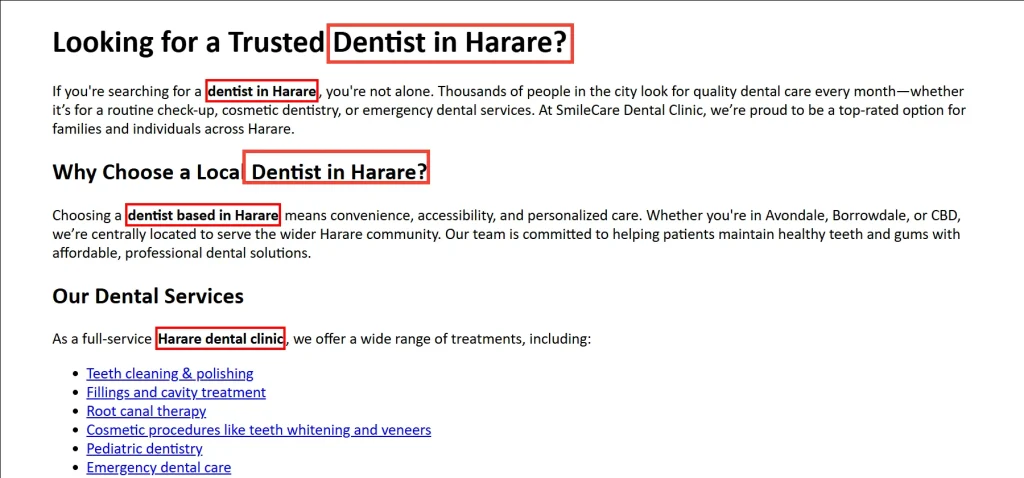
On-Page SEO: Optimizing Content for Search Engines
On-page SEO refers to all the things you can do within your website to help it rank better, including content creation, optimizing content and HTML elements.
Key Elements of On-Page SEO:
Creating Helpful content
Google and other search engines want to reward content that best answers users.
Google emphasizes EEAT which stands for:
- Experience: The content must show experience of what’s being written about, e.g. experiences of using something.
- Expertise: Showing knowledge and skill in the field.
- Authority: Are others linking to your article/page.
- Trust: Can your content and website be trusted, e.g., a secure website (HTTPS), transparent policies, accurate information, clear authorship, good reviews
You don’t have to tick all the boxes. Your content must be only good and helpful.
How to Improve Your Content & E-E-A-T
- Show author bios with credentials. You can put this below an article
- Use HTTPS and secure your site
- Get backlinks from authoritative sources
- Add case studies, testimonials, or proof of real-life experience
- Add Frequently Asked Questions below pages or posts
- Externally link to other websites with a more detailed explanation than yours.
- Keep content updated and fact-checked
- Structure your content logically. Use Headings (h1, h2, h3…h6) to create subheadings. Use only a single h1 per page
Title Tags & Meta Descriptions
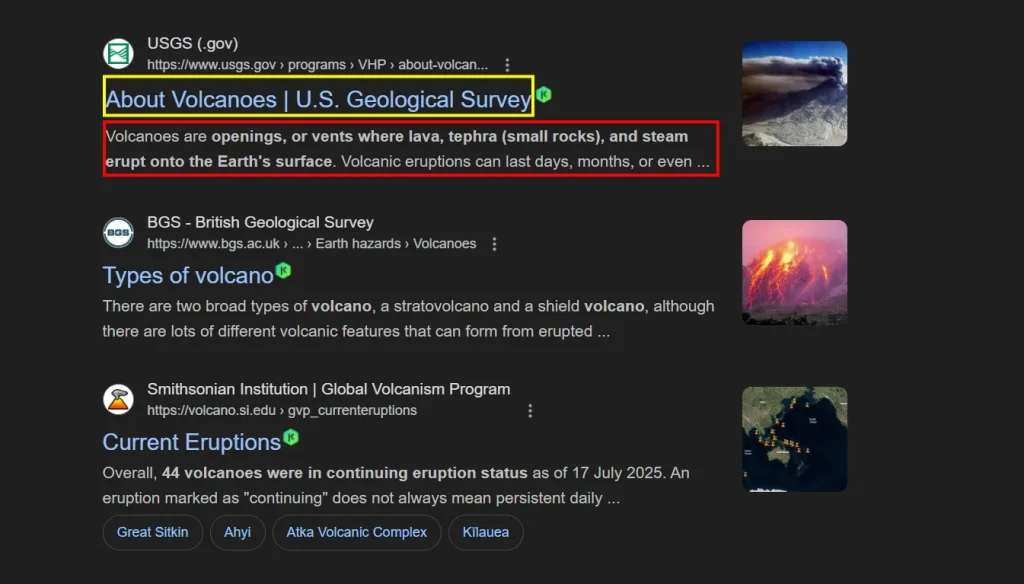
The title is the clickable blue text in the SERPs. You must include your primary keyword(s) in your title.
The Meta Description is the short summary below the title. Write compelling summaries with keywords.
The title and meta descriptions are HTML elements contained in the head tag. Here’s the Markup.
You can write titles and meta tags without coding using CMSs and plugins, e.g. WordPress & the Yoast plugin.
Keyword Placement
Naturally, include keywords in your intro, headings, and throughout the body. Don’t stuff keywords where they don’t belong!.
Internal Linking
Link to related content (pages) from another page. Use keyword-rich anchor text, not generic words like “Click Here”. Here’s an example of Wikipedia internal linking:
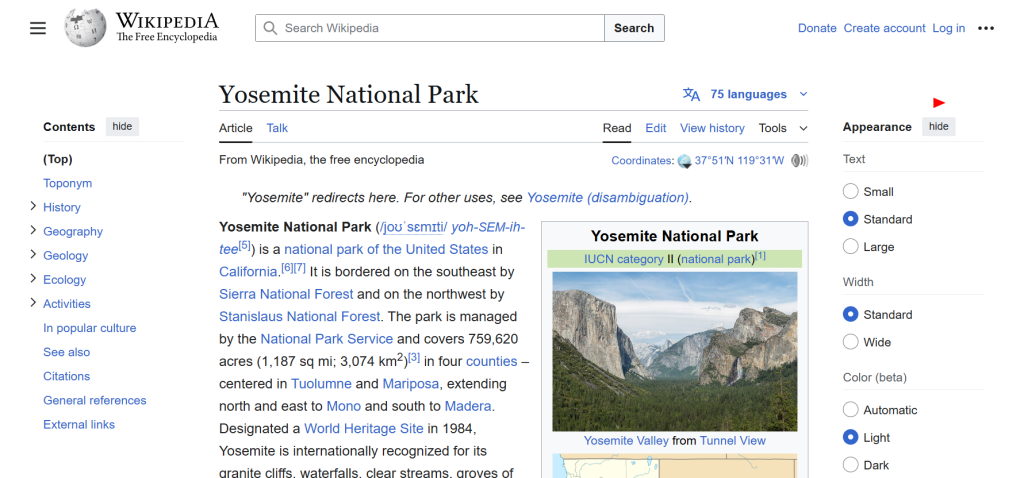
Internal linking helps boost Topical authority, spread link juice to other pages, and make other pages found.
Image Optimization
Insert images in your content where possible.
Describe images fully with keywords using the alt attribute. The alt is an image attribute used to describe an image. Here’s an example:
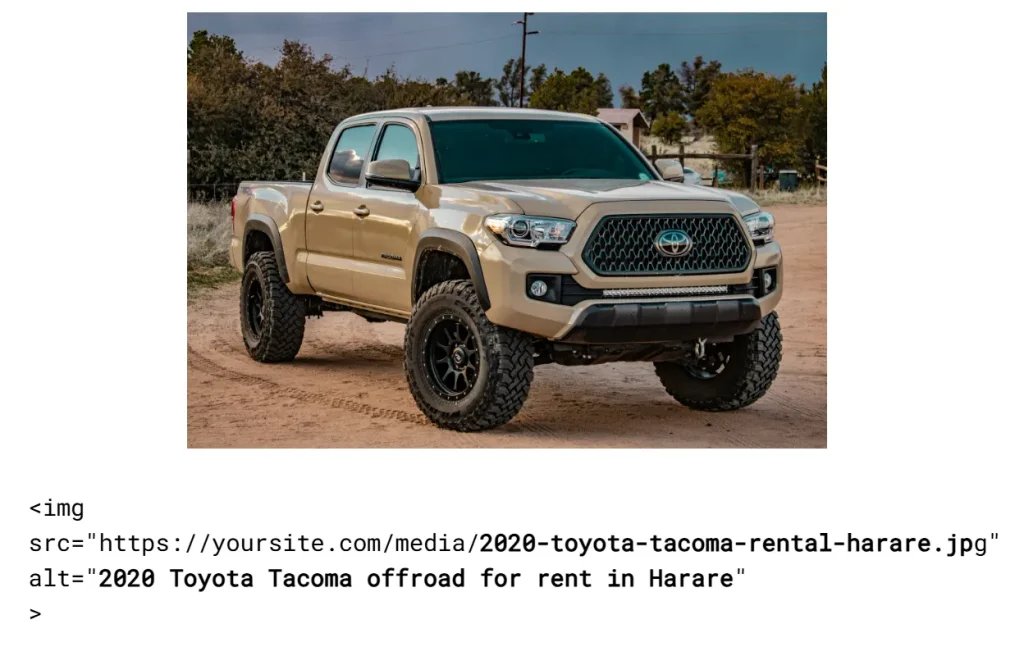
Use descriptive file names with keywords.
Make sure your images have small sizes for fast loading. You’ll find more information in the Technical SEO section.
You can add alt tags manually through code or easily using a CMS like WordPress. WordPress allows you to add the alt description when you insert an image in the editor.
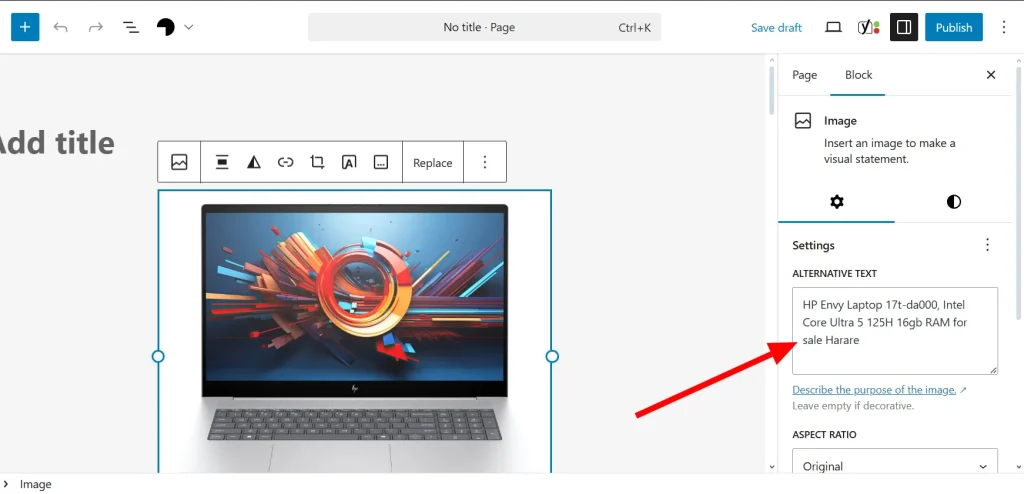
Clear website structure
Make sure your website is structured clearly so that users and search bots can access and navigate pages easily
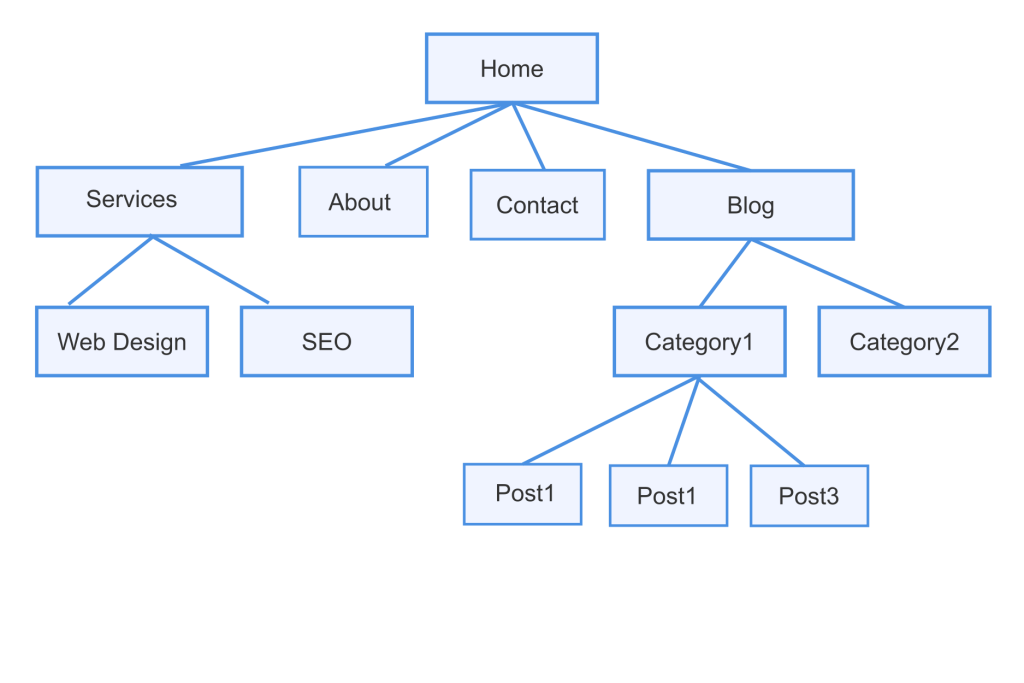
Mobile-Friendly Design
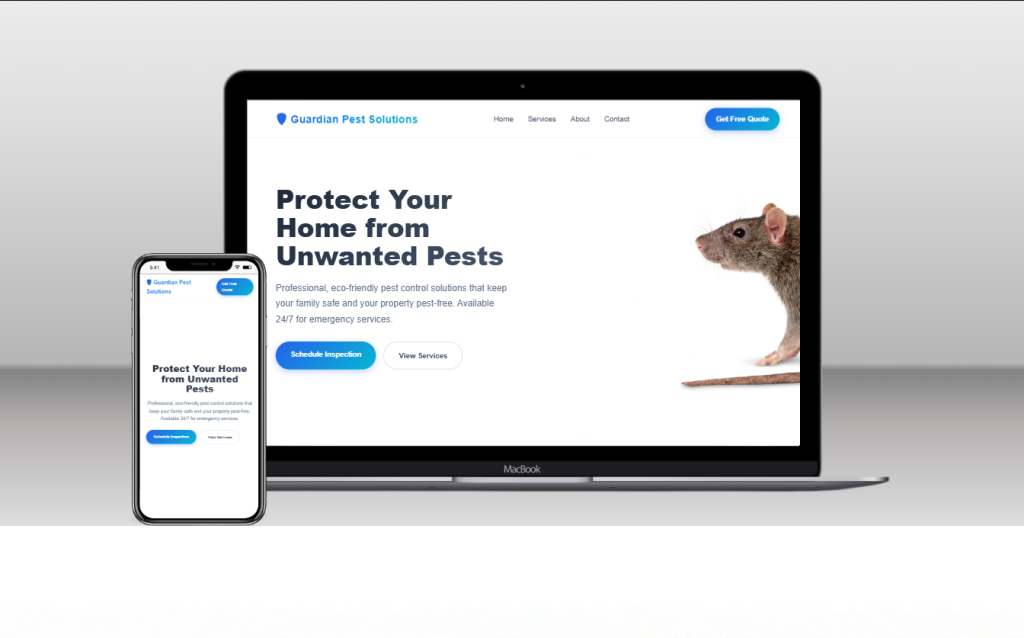
Most search engines prioritise mobile phones. Ensure your website adapts to mobile screens.
Clean URLs
Use a clear URL structure with keywords, e.g., yoursite.com/dentist-harare.
Avoid ugly URLs with excess query parameters, e.g. https://yoursite.com/?id=erqwqsa323&page=12
Technical SEO: Making Your Site Crawlable and Fast
What is Technical SEO?
Technical SEO focuses on your website’s infrastructure. It ensures that search engines can crawl, index, and render your website effectively.
Technical SEO should actually be the first step before all others because if search engines can’t access your pages, then there’s no SEO you can do.
Technical SEO Checklist:
Site Speed
Make sure your site loads fast. Speed is a ranking factor. If people bounce from your website it could signal to search engines that the page doesn’t offer value or has poor user experience, therefore dropping rankings.
Tips to increase website speed:
- Reduce Image Size: Compress images and use next-generation formats like .webp and .avif that offer high quality images at small sizes. You can use this image converter tool.
- Reduce loaded files: Minimise the amount of files (JavaScript, CSS) that are loaded. You can combine some scripts together or inline them.
- Minification: Reduce CSS and JavaScript file sizes by using minification.
- Use caching: Cache static files that don’t change often( like images) or a long time, e.g a year.
- Fast Web Host: If there are no improvements after doing the above, then consider upgrading to a faster web server.
Mobile Responsiveness: Mobile Responsiveness can be part of technical seo as well. Use a mobile-first design.
Use HTTPS
Secure your website using an SSL certificate. If your site shows a security warning, then you have no SSL installed on your website.
XML Sitemap
A Sitemap is a file that lists all pages on a website. A .xml sitemap is the more popular choice, though they’re other sitemap types like .html and .txt sitemaps.
Submit your sitemap to Google Search Console.
How to create a sitemap
You can use free sitemap generators or the Yoast plugin which generates sitemaps automatically.
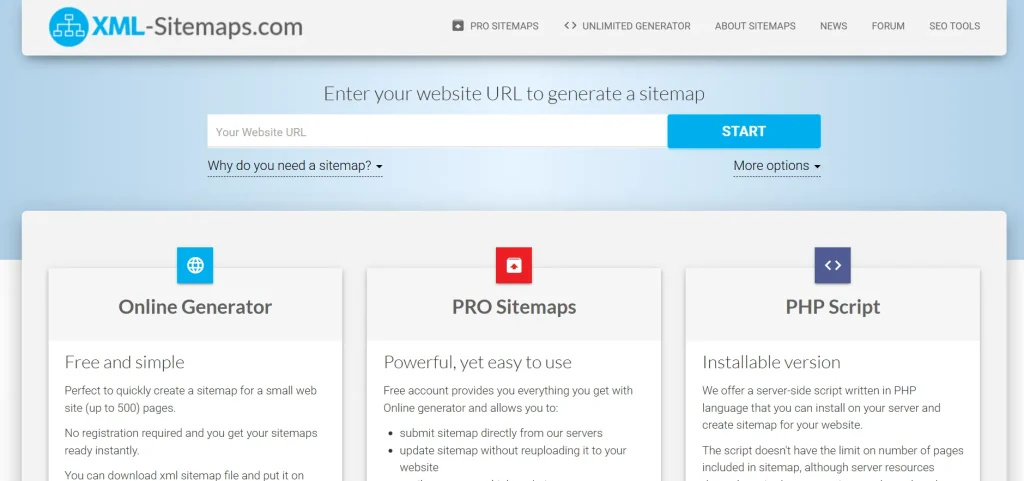
Robots.txt
A robots.txt is a text file that blocks search bots from crawling certain pages.
If this file is present in the root of your website, make sure it’s not accidentally blocking important pages in the robots.
Canonical Tags
Avoid duplicate content issues. Add “rel=canonical” to indicate the original page.
Fix Broken Links
Use tools like Screaming Frog or Ahrefs to find 404 errors.
Structured Data (Schema Markup)
Help search engines understand your content better by implementing extra structured Data. Schema Markup also displays rich-results such as images, star ratings, forum answers in the SERPs.
Tools to assist with technical seo:
Google Search Console: Analyse indexed pages, submit sitemaps, manually index pages.
PageSpeed Insights: Use this to analyse website speed.
Off-Page SEO: Building Authority and Earning Trust
What is Off-Page SEO?
Off-page SEO involves activities outside your website that impact rankings. The main focus is building backlinks—links from other websites to yours.
Why Backlinks Matter?
Google treats backlinks as votes of confidence. The more high-quality links to your website, the more authority and trust, which boosts your website’s rankings.
Backlinks are also crucial if you’re going for competitive niches.
Off-Page SEO Techniques
Guest Blogging
Write valuable content for other sites. Inside the article you can reference your site or another page on your site for readers to earn more.
Digital PR
Reach out to blogs, media, and influencers to link to your valuable articles. You can approach to cite your article in theirs.
Broken link replacement
Find broken external links on potential sites that you want links from, reach out to them, and suggest your article as a replacement.
Online tools
Create simple online tools, e.g. calculators, converters that acquire links naturally.
Social Sharing
Share your posts on social media. This boosts visibility and may lead to links.
Local SEO & Citations
Get listed in local business directories.
Online Reviews
Encourage happy customers to leave reviews on your Google business profile.
Tips for link building
- Focus on quality links: Getting a single backlink from a high-authority site is more valuable than 100 low-quality links.
- Build value: Approach people with something valuable to exchange with. Don’t ask for links without offering value.
- Avoid black-hat link building schemes, e.g. PBNs, link farms etc.
Other SEO:
Local SEO
Local seo focuses on boosting rankings in local searches such as city and country.
Tips for ranking in local searches
- Use local TLDs such as .co.zw, .co.za. Avoid generic TLDs like .com as they can be more competitive.
- Local Keywords; Use local keywords in your content (title, meta description, and body) , e.g. dentist in Harare, car rental Harare, laptops for sale in Harare. This helps you rank for “near me” searches.
- Google Business Profile: Create a Google Business Profile. Put your business name, address, and contact details.
- Get reviews: Encourage users to leave positive reviews on your Business profile.
- Get local backlinks
👉 Dive Into Our Off-Page SEO Strateg
—
Final Thoughts: How to Start Your SEO Journey
SEO doesn’t bring results overnight, but it’s one of the most cost-effective digital marketing strategies over time. Here’s how to start:
